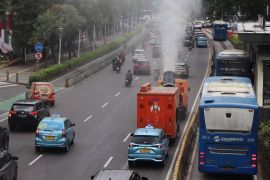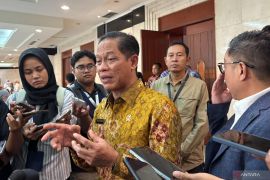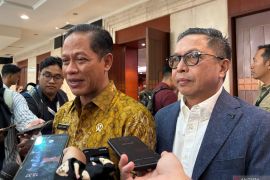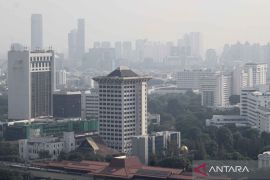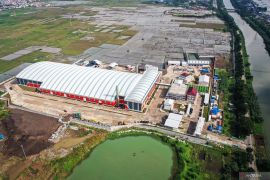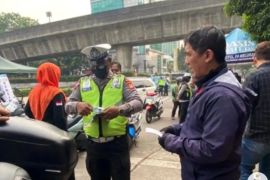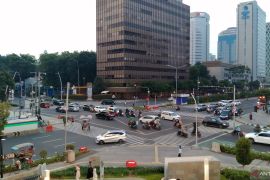People in big cities are at risk of breathing polluted air due to vehicle exhaust emissions, while those in villages are at risk from inhaling thick smoke from forest and land fires.
At the Indonesia International Sustainability Forum (IISF) 2024 held in Jakarta in early September, Deputy Minister of Health Dante Saksono Harbuwono said that the air breathed by people daily is one of the things that determine the quality of human life. Therefore it must be paid attention.
It is also important considering that the World Health Organization (WHO) has pegged the number of premature deaths per year due to exposure to polluted air at seven million.
According to data from state health insurer BPJS Kesehatan, in 2023 alone, respiratory diseases were among the top 10 illnesses that the agency incurred the highest medical expenses on, including outpatient and inpatient care.
In the outpatient care category, 1.1 million cases of respiratory diseases were recorded with the cost of treatment amounting to Rp431 billion (around USD27.96 million). Meanwhile, there were 1.7 million cases requiring inpatient care, with the treatment cost running up to Rp13.3 trillion (around USD863 million).
As per the BPJS Kesehatan data, the number of cases of acute respiratory infection (ARI) experienced an uptick during the period. Based on outpatient data at primary health facilities (FKTP) such as community health centers and clinics, 3.5 million people were diagnosed with ARI, a 10.4-percent increase compared to 2022.
Meanwhile, data from advanced referral health facilities (FKRTL) showed an upward trend in cases nationally, especially after the COVID-19 pandemic.
As per outpatient data, the average treatment cost stood at Rp32.9 billion with 159,251 cases recorded before the pandemic, and afterward, the figure rose to Rp45.2 billion with 210,291 cases.
Taking note of this, Harbuwono emphasized that improving the air quality in Indonesia will help improve people's quality of life, especially in the health aspect.
Realizing that air pollution is a shared problem, the Ministry of Health has integrated air quality data of the Ministry of Environment and Forestry into the SATUSEHAT application, which can be accessed in real-time.
The data integration is aimed at increasing public awareness about the risks of carrying out outdoor activities when the air quality is poor.
The Ministry of Health is also continuing to ramp up the dissemination of information to the public on the impact of air pollution, as well as encouraging the use of masks when performing outdoor activities in poor air quality.
Air pollution handling
To realize good air quality, the first step is identifying the causes of air pollution, not only in metropolitan areas but also in other areas that are at risk of smoke exposure during certain periods every year.
According to Director General of Environmental Pollution and Damage Control at the Ministry of Environment and Forestry Sigit Reliantoro, the majority of cases of air pollution in Indonesia can be attributed to several factors, such as forest and land fires; pollution from energy generation, for instance, at coal-fired power plants (PLTUs); and urban activities.
Each of these factors requires specific handling. Therefore, a single-solution approach cannot be used to resolve all problems related to air pollution.
Currently, the Ministry of Health is focusing on increasing awareness among various stakeholders. Not only that, ministries and the relevant institutions are also continuing to carry out monitoring and maintaining their own data related to air pollution.
However, further efforts are needed to translate the data from each sector into concrete actions at the grassroots level.
Concrete measures can be taken when all parties are aware that air pollution is a common issue, and not a problem that can be addressed individually.
Reliantoro said that one form of cooperation to handle air pollution is collaboration in handling forest and land fires.
For the purpose, a team chaired by the regional head can be formed in provinces that are prone to forest and land fires. The team could discuss handling measures based on a scientific approach with relevant ministries and institutions.
The same approach can be applied to address wider air pollution. Ministries and institutions already have monitoring mechanisms and regulations in place to handle air pollution. Data integration can help them translate them into action in the field.
However, he also highlighted that for certain areas, such as Jakarta and its surroundings, institutional handling is necessary, including the establishment of an air quality monitoring authority for the areas of Jakarta, Bogor, Depok, Tangerang, and Bekasi, as well as industrial areas such as Karawang and Indramayu.
The Indonesian government, on its part, has not been silent about air pollution. The IISF 2024 was one of the platforms to discuss and determine solutions based on good practices implemented in other regions of the world.
Deputy for Infrastructure and Transportation Coordination at the Coordinating Ministry for Maritime Affairs and Investment Rachmat Kaimuddin said that Indonesia is facing the same problem faced by several countries several decades ago.
The identification of the problem has been carried out, and it has been found that air quality and energy transition are closely related.
The root problem is also the same, namely combustion, which leads to carbon emissions and causes air pollution. If there is a solution to one problem, the solution to the other problem will be found.
To seek solutions, the Indonesian government slated the energy transition as one of the main discussion topics at the IISF, including environmentally friendly resources and funding to bring about an increase in the use of public transportation and reduce pollution from PLTUs.
The government is also pushing for more research and studies on reducing pollution from PLTUs and vehicles. There have also been efforts to improve the quality of fuel in Indonesia, which currently does not meet Euro standards.
The initial step was taken in Jakarta with the electrification of TransJakarta buses. So far, 100 electric buses have been pushed into service, and an additional 200 buses will be rolled out at the end of 2024.
There is also a commitment to purchase 100 percent electric buses for new single-bus procurement in the future.
The government is also evaluating the possibility of expanding the low-emission zone (LEZ) implementation.
Apart from that, attention is also being accorded to PLTU emission standards in Indonesia, which currently still lag behind those of other countries such as China, India, the European Union, and the United States.
The Indonesian government is evaluating ways to reduce PLTU emissions and improve the standards in the future.
One of its plans to achieve this is the early retirement of the Suralaya PLTU and Cirebon PLTU, which are among the 400 projects identified by the government to support the achievement of net zero earlier than the 2060 deadline.
These measures reflect the government's serious commitment to addressing air pollution to realize better life quality for Indonesians.
Related news: Indonesia's ministry encourages evidence-based air pollution policies
Related news: Indonesia steps up use of electric buses to tackle air pollution
Editor: Rahmad Nasution
Copyright © ANTARA 2024





